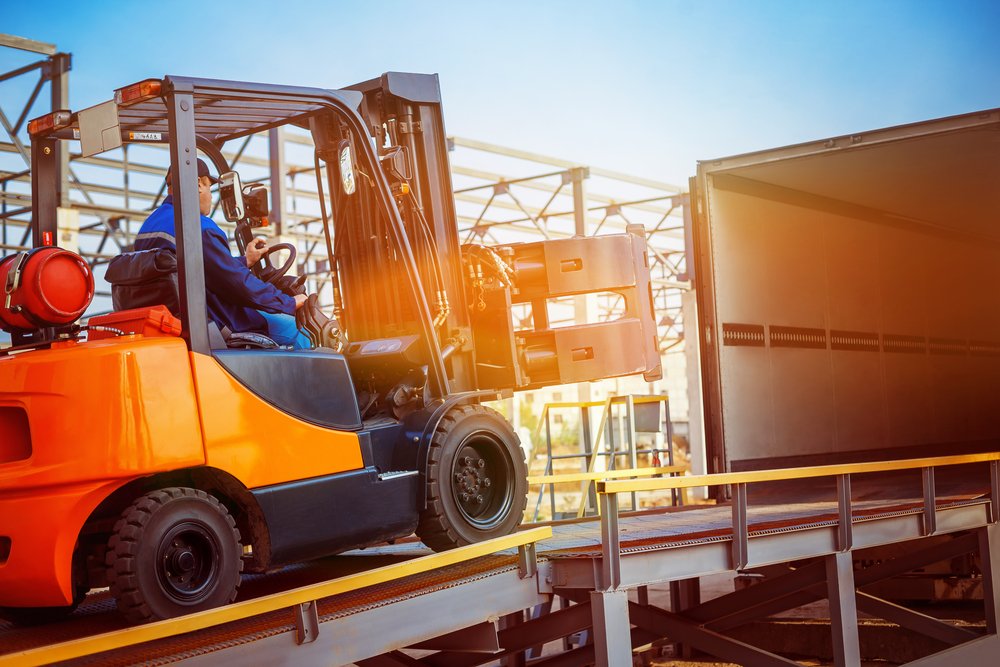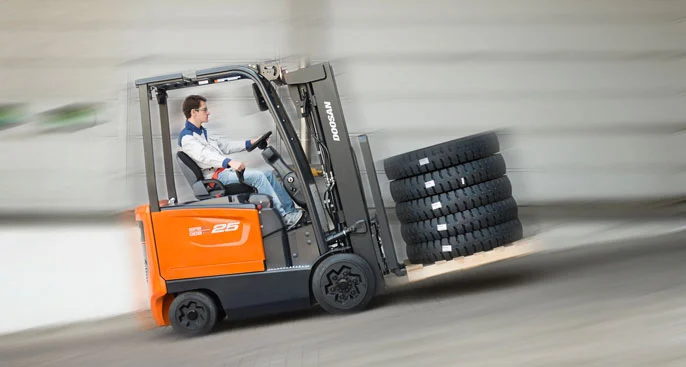In the bustling industrial and warehouse sectors of Houston, TX, and Humble, optimizing forklift travel speed isn’t just a matter of operational efficiency—it’s a cornerstone of workplace safety and productivity. Upright Forklift Repair, a leader in forklift service, understands the critical balance between speed and safety.

Forklift travel speed, a key factor often overlooked, can significantly influence the smooth operation of logistics and storage facilities. Too fast, and the risk of accidents and equipment damage increases; too slow, and it may lead to reduced throughput and operational bottlenecks.
This is where the expertise of Upright Forklift Repair comes into play, offering tailored solutions that ensure your forklifts operate at optimal speed, adhering to both safety standards and operational needs. Whether it’s routine maintenance, speed adjustments, or consulting on the best practices detailed in the service manual, optimizing your forklift’s travel speed is essential for maintaining a competitive edge and ensuring a safe working environment.
Understanding Forklift Travel Speed
Forklift travel speed is a critical parameter that dictates how quickly a forklift can move from one point to another within a workspace. Governed by factors such as the forklift’s design, load capacity, and operational settings, travel speed can greatly influence a warehouse’s overall efficiency and safety. The speed limit of a forklift is not just an arbitrary number; it is carefully calculated to balance efficiency with the well-being of operators and pedestrians.

Understanding the implications of how fast a forklift can go is essential for warehouse managers and operators alike. High speeds may promise quicker task completion, but they also increase the risk of accidents, potentially leading to serious injuries or damage to goods and infrastructure. Conversely, excessively slow speeds can hamper productivity, creating delays and reducing the overall throughput of operations.
The Basics of Forklift Speeds
Adjusting the travel speed of a forklift is a nuanced process that requires understanding your machine’s specific capabilities and limitations. For operators of Toyota and Hyster forklift models, here are some steps and considerations for adjusting speeds safely and effectively.
For Toyota Forklifts:
- Consult the Service Manual: Always start by consulting your forklift’s service manual. It contains model-specific instructions and safety warnings.
- Access the Electronic Control Module (ECM): Speed adjustments in newer models can often be made through the ECM, using a digital interface or a special adjustment tool.
- Manual Adjustments: For older models, speed may be adjusted manually via screws or valves on the forklift’s engine or hydraulic system. Proceed with caution and consult a professional if unsure.
For Hyster Forklifts:
- Reference the Service Manual: Like with Toyota, the service manual for your Hyster model will provide the most accurate guidance.
- Adjusting Speed Settings: Hyster forklifts might require a certified technician to adjust the speed settings through proprietary software or manual adjustments, depending on the model.
- Safety Precautions: Ensure that any adjustments are within the safety guidelines to prevent accidents.
Adjusting the speed limit or making a forklift go slower or faster requires a deep understanding of the machine. When changing speeds, consider the forklift’s application, the typical load weight, and the operating environment to select the most appropriate speed setting.
Why Forklift Speed Adjustment is Crucial
Proper forklift speed settings are not just a matter of regulatory compliance; they are essential for preventing accidents and minimizing damage. Incorrect speed settings can lead to loss of control, collisions, and overturns, which not only endanger operators but also pedestrians within the workspace. Moreover, appropriate speed adjustments contribute to operational efficiency.
A forklift set at the correct speed can maneuver more safely around obstacles and through busy work areas, reducing the likelihood of product damage and enhancing productivity. The service manual of each forklift model provides guidelines on the recommended speed settings for different operating conditions, emphasizing that safety and efficiency are directly influenced by how well these guidelines are followed.
Speed Adjustment and Safety
Warehouse Efficiency Improvement
A logistics company faced frequent delays and minor accidents in its warehouse operations. By consulting with experts and revisiting the factory settings on their fleet of forklifts, they implemented a series of speed adjustments tailored to different areas of the warehouse. The result was a significant reduction in accidents and a smoother flow of operations, proving the importance of customized speed settings.
Reducing Product Damage
A retail distribution center struggled with high levels of product damage during handling and transport. After analyzing the situation, it was determined that the forklifts were operating at speeds higher than necessary for the precision required. By adjusting the forklift speeds to slower, more controlled settings, the company saw a dramatic decrease in damage, showcasing how speed adjustments can lead to more careful handling and cost savings.
These cases underline the critical role that proper forklift speed adjustment plays in enhancing safety and efficiency. By adhering to recommended settings and making informed adjustments, companies can achieve better operational outcomes and reduce the risk of accidents and damage.
How To Adjust Your Forklift Speed
Adjusting your forklift’s speed requires careful consideration and adherence to the manufacturer’s guidelines to ensure safety and efficiency. Here’s a general step-by-step guide:
- Consult the Service Manual: Begin with the forklift’s service manual, which provides specific instructions on adjustments for your model.
- Identify Adjustment Mechanisms: Locate the speed adjustment mechanism, which could be a knob, screw, or an electronic setting, depending on the forklift model.
- Understand Factory Settings: Be aware of the factory settings and the recommended speed limits to ensure you’re making adjustments within safe parameters.
- Make Adjustments: Adjust the speed setting as required. For electronic adjustments, you might need to enter specific codes or navigate through a menu on the forklift’s onboard computer system.
- Test the Adjustment: Safely test the forklift in an open area to ensure the new speed setting is appropriate for your operational needs.
DIY Tips vs. Professional Service
While adjusting forklift speeds might seem straightforward, there are significant advantages to enlisting professional services like Upright Forklift Repair. Professionals have the expertise and tools to accurately adjust speeds, diagnose underlying issues, and ensure the adjustments comply with safety standards.
Furthermore, Upright Forklift Repair can offer comprehensive services, including maintenance checks, spare parts, and advice on optimal settings for your specific operational environment, providing peace of mind and freeing your team to focus on core business activities.
Choosing the Right Service Provider
When selecting a forklift repair and service company, consider expertise, range of services, and customer support. Upright Forklift Repair stands out in the Houston and Humble areas for its experienced technicians, comprehensive service offerings, and dedication to customer satisfaction. A reliable service provider should offer transparent pricing, a track record of success, and swift response times to minimize downtime for your operations.
Upright Forklift Repair: Your Trusted Partner
Upright Forklift Repair, serving Houston, TX, and Humble, is your go-to source for forklift maintenance, service, and spare parts. With a deep understanding of various forklift models and a commitment to excellence, Upright Forklift Repair ensures your fleet operates at peak efficiency.
Whether you need speed adjustments, routine maintenance, or emergency repairs, our team is equipped to provide high-quality service that minimizes downtime and maximizes productivity. Choose Upright Forklift Repair for reliable service that keeps your operations moving smoothly.
Enhance Your Forklift’s Performance Today
Optimizing your forklift’s travel speed is not just about compliance or safety; it’s a strategic move to enhance efficiency and save on operational costs. Precise speed settings can significantly reduce the risk of accidents and wear on your machinery, extending the lifespan of your fleet and safeguarding your personnel.
Upright Forklift Repair specializes in adjusting forklift speeds to match your specific operational needs. With access to comprehensive service manuals and a wealth of experience in forklift maintenance, our technicians ensure your machines operate efficiently and safely. By choosing Upright Forklift Repair, you’re not just changing speeds; you’re investing in the longevity and productivity of your forklifts. Let us help you achieve the perfect balance of speed and safety, enhancing your forklift’s performance from end to end.
Why Choose Upright Forklift Repair?
Specializing in speed adjustment, service, and providing quality spare parts, including essential forklift safety parts, we pride ourselves on delivering top-notch service that keeps your operations running smoothly. Our team of skilled technicians is dedicated to ensuring your forklifts are performing at their best, with safety and efficiency as our top priorities.
Whether you’re looking to fine-tune your fleet’s travel speed, require regular maintenance, or need emergency repairs, Upright Forklift Repair has the expertise and resources to meet your needs. Don’t let forklift performance issues slow down your business. Contact Upright Forklift Repair today to learn how we can help enhance your forklifts’ performance, ensuring they’re always ready to meet the demands of your operations.
